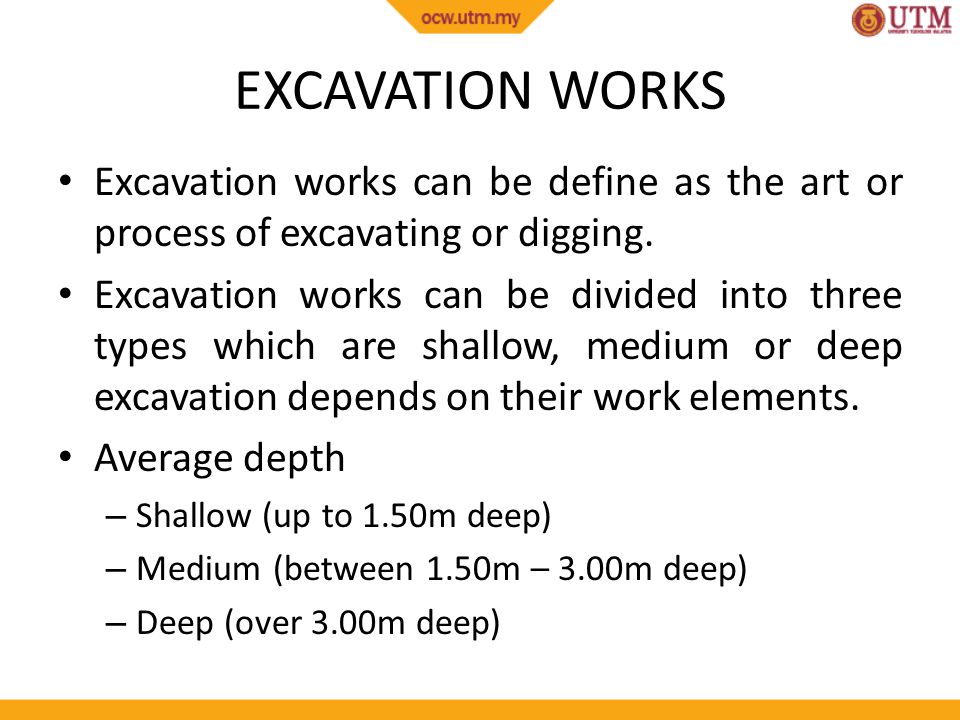About Excavation Companies
Wiki Article
Little Known Facts About Excavating Contractors.
Table of ContentsMore About TrencherExcitement About Excavating ContractorsThe Basic Principles Of Trencher The smart Trick of Excavator That Nobody is Talking AboutThings about Excavating Contractors


Scrapers or Pans dig deep into soil in one location, haul as well as dispose the soil in another spot (excavator). It is challenging to match the efficiency of scrapes for cut/fill dirt procedure if the haul range is much less after that a mile. Scrapes are typically pulled by a rubber tire wheel tractor and are often pushed via the cut location by an excavator.
There are often times that scrapes are not utilized for site grading as well as a dump vehicle is utilized: the haul might be to long, the haul might go across roadways where scrapes are not permitted, acid rock might be come across, tools availability, etc. Discard vehicles are in typical usage as well as probably call for little conversation.
"Rock body" beds, on the other hand, have no tailgates and also can discard any type of size rock, although their quantity capacity is diminished. Compaction Tools raises the thickness of the soil as well as in some situations provides a smooth, rolled surface.
Concrete Contractors Fundamentals Explained
From a straightforward test pit to percussion drilling to core boring the owner has significantly much more pricey options that yield progressively better information about the website underground. The Owner on a 100,000 SF building task might authorize twenty uninteresting areas with split spoon soil examples taken until rock is reached as well as then core examples of rock.Knowing the type and top quality of rock (from the core examples) and also location of rock (from the soils boring) is an actual advantage in jobsite preparation. Alternatively, the Owner of a 100,000 SF structure might make a decision to continue with no geotechnical testing whatsoever. The decision about geotechnical screening is usually made by a Proprietor with no input from the Building and construction Supervisor.
A knowledge of the approximate place of the rock aids the Building and construction Supervisor to prepare the series of steps adhering to rock excavation. If rock is in one edge of a big structure task, for example, the earth excavation could begin at the contrary end of the structure in order to begin foundation job soonest.
Starting the foundation work early would be a great idea if the rock might be eliminated by tearing. If the rock is very hard as well as calls for significant blasting, it might be prudent to hold structure work up until the blasting is completed. The Construction Manager need to collaborate these sorts of decisions as well as make use of all the technological day offered.
A Biased View of Excavator
Unidentified excavation specifies that all rock or various other unanticipated products (omitting hazardous materials) run into in the sitework will certainly be the responsibility of the Contractor at no change in agreement price. An unclassified excavation is less complex from a book-keeping point ofview as well as puts the obligation for geotechnical conditions onto the Sitework Professional.Exactly How Water Influences Sitework? It's impressive what a hefty rain can do to a building job. Before the rain, the website may be completely dry, heavy tools effectively relocating planet, the other trades efficiently executing their work. Within hours the project can be a careless, mud-hole with worker performance cut to concerning 10%.
In many locations of the globe, the Construction Supervisor should bear in mind a straightforward fact: IT WILL CERTAINLY RAIN. Good planning can minimize the damage and interruption of a hefty rain to a jobsite. Typically a knockout post the excavation and also grading is delegated the Sitework Service Provider (and also their Foremen is accountable to supervise and direct the heavy equipment and operators).
The Construction Manager must be continually mindful of what rainfall will certainly do to the task website. It is not unusual for the Sitework Supervisor to function their heavy devices for maximum effectiveness as well as hope it does not rain. One of the most effective ways to prepare for rainfall is to slope all qualities to drain pipes and to smooth rolled the surface area before a rainfall.
3 Simple Techniques For Excavating Contractors
The Building and construction Manager have to be perceptive enough to insure that heavy rain does not quit working on the job longer than required. Daily discussions with Sitework Foremen may be called for to achieve this objective. Whenever excavation is required below the existing water level on a project, the procedure of dewatering have to be taken into consideration.In a truly natural dirt, the water travels so slowly via the clay or silt that dewatering is not normally needed for the reasonably short time of excavation. Dewatering may be needed for a solitary footing excavation or for a whole job website. The most usual dewatering methods are trench drains pipes, deep wells and well points.

Ground water seepage can likewise be decreased by cutoff approaches such as sheet stacking. High dewatering costs have faded the profit margins on much as well lots of jobs.
This option needs to always be taken into consideration when examining the possibility of dewatering. Certainly the alternative is just practical if gravity can run the water to reduced ground. Trench drains can be reduced with a backhoe as well as loaded with a crude, granular material (# 4 stone as an example), yet treatment needs to be exercised in selecting the water Continue outlet type as well as location.
The Main Principles Of Excavating Contractors
A siphon, necessarily, makes use of atmospheric stress to bring water from one elevation, up over a challenge, to a lower altitude. The pipelines in a siphon system should be closed and also some ingenuity is typically called for to completely like this fill the siphon pipe. The siphon pipeline should be complete for the siphon to start.A deep well includes a pump, hose and also an upright well casing. The pump intake is at the bottom of the well casing (normally some smashed stone is placed down there as a filter medium) (excavator). The water is pumped up the pipe, out of the well covering, as well as to an appropriate discharge area.
In a coarse sand, for instance, a big area can be pumped to near the pump intake altitude. A much less absorptive dirt, on the other hand, lowers the performance of a deep well. Given that the pump is generally at the end of the deep well, there are no height limitations because of vacuum lift, as well as deep wells can reduce the groundwater over 50 feet.
Under of the wellpoint there is a 2 foot long screen and shutoff, water jets out of this valve as well as produces a hole right into which the wellpoint pipe can be reduced. This opening is typically made a larger diameter (for example 10 inches) to enable a coarse sand backfill to aid filter the water (general contractor).
Report this wiki page